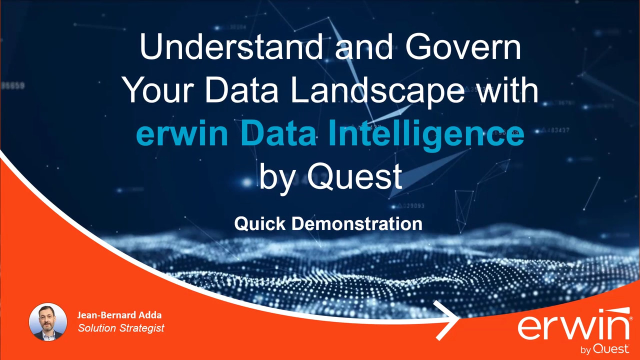[MUSIC PLAYING] Welcome, everybody. Today, we'll go through a quick demonstration of how data intelligence suite solution, how [INAUDIBLE] within intelligence suite it helps our customer better understand, manage, and govern their data landscape. My name is Jean-Bernard Adda, solution strategist for the EMEA region.
In this case, the end user, who can be a business leader, portfolio manager, or business analyst reviews the financial investments of the company [INAUDIBLE] by BU, OpEx, and CapEx criteria. Reviewing the power BI dashboard, how portfolio Manager zooms in the details of the grid plot [INAUDIBLE], reviewing each column and especially the financial numbers.
He's surprised to see 0 in the opposite column regarding the credit card processing and mobility security investments. He decides to contact the chief data officer to get further information. The CDO or [INAUDIBLE] director accesses a business user portal and uses the Elasticsearch capability to retrieve any information related to the name of the [INAUDIBLE] dashboard.
The powerful search capability of the intelligence so the CDO will show immediately any kind of information, whether they are technical or business-oriented. And indeed, in this case, how dashboard appears and is immediately available from the dashboard business term section.
The details of this business asset confirms that this is the right one. It shows the sensitivity, the status, which is, of course, workflow driven, the governance responsibilities, and even preview capabilities available.
The mind map differentiating feature gives all the context needed to investigate and have a clear understanding of the situation. Reviewing the information, he can drill down into the grid portlet, and realizes that the methodology is also available information that can give more visibility.
Trailing down, you can move immediately from the business information into the related technical column. This is a key feature to visualize, understand, and [INAUDIBLE] the data in context. After reviewing the detail and governance responsibilities, he decides to create a request access to get this information handy to the report.
Now, the request comes to the BI analysts, or BI developer, and as the intelligence suite [INAUDIBLE] maintain the relationships between business and technical information using its artificial intelligence matching algorithm. He just has to have properly the methodology field and publish the updated dashboard.
The information is updated in the system, the CDO is notified, and the business user can refresh its dashboard and immediately consume the new data available.
While deep diving in the report, he realizes that the project that do not have OpEx information are both agile initiatives. Then he asked for further investigations.
It's now time to [INAUDIBLE] data steward or the data owner, asked by the CDO, to explore, analyze, and get a clearer understanding of the situation. Very quickly, you can review the wall lineage from the dashboard to the technical column used to display the OpEx information, understanding data in context, which significantly increased productivity and day-to-day efficiency.
What the lineage provides at a glance a representation of the data motion, showing data movement through all involved systems and environments of the [INAUDIBLE] Chain management, financial database, Snowflake environment, and, of course, how consumption layer [INAUDIBLE].
Also, immediately from the business user portal, how data steward quickly reviews the detail of the Snowflake environment, and can review all system environments which feed or consume the information. Awesome.
Something to stress to him, the SNEDW environment feeds Tableau and Power BI but one table only of Snowflake feeds Tableau and does not feed Power BI. Then it drills down into the code, level and see that the scope of both reporting tools are the same. From this incredibly powerful feature, it can accurately understand how each field is providing where it comes from, where it goes to, how the transformations, [INAUDIBLE], business rules, and more.
This is incredibly time-saving, having a clear visibility and understanding of your data. As we know that 80% of the time is dedicated to identify and prepare the data, this is a powerful accelerator to the business.
And you realize it's that one environment dedicated to the agile projects feeds the Snowflake database, which feeds Tableau. It does not feed Power BI. A zoom into the column level confirms that the OpEx information coming from the agile [INAUDIBLE] only show the Tableau environment. He has clearly identified the situation, and he can contact a more technical data profile to fix it. Profile like data architect, data engineer, or data developer are driven to address this point.
Very quickly and easily, how the developer reviews the data mapping and updates [INAUDIBLE] not that how smart connector how customer capture and automate the data in motion reverse engineering the code of the technologies in place, and documenting transformation, business [INAUDIBLE] lookups, et cetera.
Companies are moving from 0 to more than 80% fully automated data governance system, unique source of truth, and a clear understanding of where the data is, where it goes, who is using it, how it is transformed through the systems. You can also easily imagine the value for compliance and regulation of [INAUDIBLE] issues.
Now, back to our system. The lineage has been updated, and the OpEx information is also propagated to the [INAUDIBLE] analytics for application. Back to our financial investment dashboard, business user refreshes his screen, and he can finally review the OpEx information of the agile projects.
Thank you for watching this video. For further information, please contact us on erwin.com. Let's talk about what you want to achieve, regulatory compliance programs, architectural modernization, digital transformation, operational efficiency initiatives, rationalization programs, ask for a demo. Thank you, and see you soon.
 07:19
07:19
